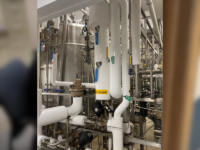Blog post by Tanner Grieve, Mechanical Engineer
 A safety programmable logic controller (PLC) is like a standard PLC. It can be used to control and automate pieces of industrial equipment. A safety PLC supports all the applications that a standard PLC does; however, a safety PLC contains integrated safety functions that allow it to control safety systems as well. As William Goble explains in his article, Learn to Trust Safety PLCs, published by Putnam Media, a safety PLC is designed to accomplish two important objectives: Do not fail, and, if unavoidable, fail only in a predictable safe way. It achieves these objectives through its redundant microprocessors, eliminating the need for safety relays to create redundancy. It also has built-in diagnostics allowing it to continuously monitor inputs and outputs. Should an internal fault or failure be detected, a safe shut down of the PLC will occur.
A safety programmable logic controller (PLC) is like a standard PLC. It can be used to control and automate pieces of industrial equipment. A safety PLC supports all the applications that a standard PLC does; however, a safety PLC contains integrated safety functions that allow it to control safety systems as well. As William Goble explains in his article, Learn to Trust Safety PLCs, published by Putnam Media, a safety PLC is designed to accomplish two important objectives: Do not fail, and, if unavoidable, fail only in a predictable safe way. It achieves these objectives through its redundant microprocessors, eliminating the need for safety relays to create redundancy. It also has built-in diagnostics allowing it to continuously monitor inputs and outputs. Should an internal fault or failure be detected, a safe shut down of the PLC will occur.
For a PLC to be considered a safety PLC, it must meet a set of rigorous international standards, specifically IEC 61508 – Functional Safety of Electrical/Electronic/Programmable Electronic Safety-related Systems. This standard covers design, design methods, and the testing of hardware and software. It also acknowledges that zero-risk can never be achieved, but that non-tolerable risks must be reduced as low as reasonably practicable. These standards are enforced by third-party experts such as TÜV Rheinland and UL during the certification process. Since it is very important for safety PLC’s to have a high level of diagnostic coverage, it is a big part of determining whether a safety PLC is, in fact, safe.
For a safety PLC to achieve a safety integrity level (SIL) of three (3), it must be capable of detecting over 99% of potential failures. Some of the testing required to determine the diagnostic coverage involves a series of tests like data verification and program flow control. These tests ensure that the PLC stores critical data and verifies the internal functions the PLC executes are in the correct order. In addition, a safety PLCs must undergo software-fault injection testing. This is where programs are corrupted and downloaded into the PLC to verify that the PLC responds in a safe way[1].
But what are the advantages of a safety PLC compared to a standard PLC? A safety PLC allows for safety control and standard control while a standard PLC only allows the latter. By using a safety PLC to control a safety system, time and money are saved on field wiring since there is no need for safety relays. As a result, a safety system designed around a safety PLC is extremely flexible. It is easy to modify because it simply requires programming changes but does not require any wiring changes or additional relays. Once the safety system has been tested and validated, the safety program in the PLC can be locked and password protected to prevent unauthorized variations. Certain models even support integrated motion over Ethernet, and can be used to initiate safe torque-off function on various types of variable frequency drives (VFDs).
There are however, some disadvantages to using a safety PLC as well. The upfront cost is higher, so this type of PLC would not be ideal for smaller, simpler applications. An example would be a system that only requires one E-stop button and a light curtain. It would likely be easier to just simply use a safety relay and hard wiring for the safety system. Another important thing to note is that safety PLCs are still a relatively new product with new technology. Engineers and maintenance technicians are unfamiliar with the newer technology so additional training may be necessary for safety PLCs to be used correctly.
Many don’t fully trust the reliability and have doubts regarding the integrity of the safety system. While safety PLCs are still a relatively new concept, they have already found their way into safety applications in industries around the world. Undergoing strict certification processes to ensure reliability and minimize risks. Offering several advantages that can make designing a safety system much easier and less complex, they do have drawbacks as well, so it is important to determine whether or not the use of a safety PLC is appropriate for the application at hand.
References:
[1] Goble, William. “Learn to Trust Safety PLCs.” Control Design for Machine Builders, PutmanMedia, 30 May 2003. Accessed 31 Mar. 2017.




